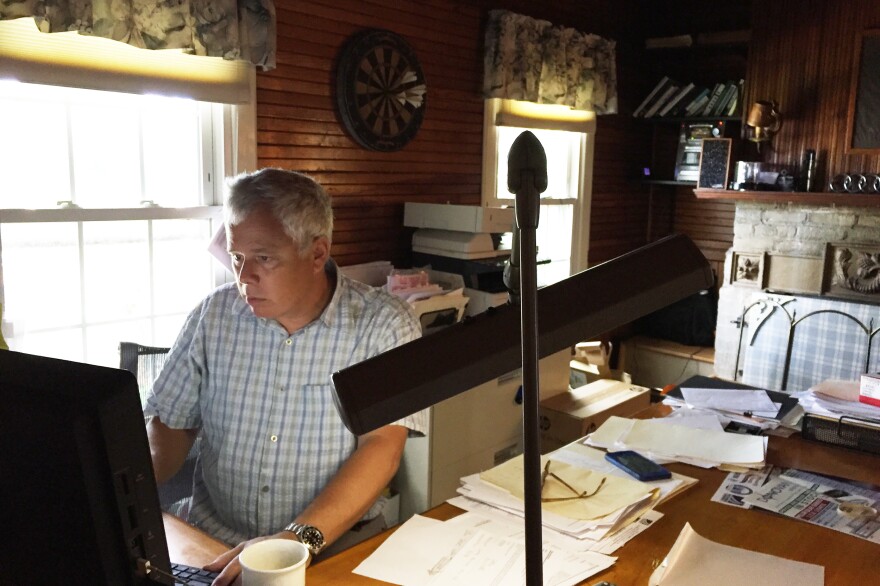Mules named Sal are hard to find these days along the Erie Canal. But almost two centuries after workers began digging its route across upstate New York, you can still see barges pushed and pulled through what some consider the first superhighway of the U.S.

As the canal prepares to celebrate its bicentennial next July, some are questioning whether the canal is still worth subsidizing.
After the original canal was completed in 1825, the 363-mile waterway was a technological marvel. It shortened the trek from eastern New York to the Great Lakes from two weeks by wagon to just five days on the water.
By today's standards, though, the ride is slow and steady with stops every so often at canal locks that act like water elevators for barges and boats.
"The canal used to be very busy," says tugboat captain Mark Smith, who adds locals didn't used to pay much attention to canal workers like him. "They probably didn't look twice at a tugboat with a fuel barge. Nobody thought anything of it. Now it's kind of a novelty."

"It was really neat to see it happen again. And it's too bad it doesn't happen more often," says Maureen Buechner, who watched Smith's tugboat, the Margot, glide through a lock in Waterford, N.Y., with a barge carrying three electrical transformers headed for a power plant. "That's how everything traveled. Now, you have trucks, trains. This is an old way of life."
But the Margot's owners aren't ready to rule it out yet.
Business is growing for the New York State Marine Highway Transportation Company, according to co-founder Rob Goldman. His crew has found steady work towing barges of stone and sometimes oversized cargo like fighter planes along an expanded Erie Canal, also known as the New York State Barge Canal, that was completed in 1918.

"Let's face it: a barge can't deliver to your front door. A truck can," Goldman admits. "But if we work with the trucks and we work with the rail, we can each be as efficient as possible and use as little fuel as possible because we're efficient."
Efficiency, though, is probably not the priority for most of the people who use the canal. Recreational boats are driving most of the canal's revenue today. Travelers like Art Cohn enjoy taking the scenic route at about five miles per hour.
"That's a really interesting way to see the world. Normally if I'm home, I'm driving, you know, highway speeds and if someone's moving too slow, I'm getting frustrated. Not on the canal," says Cohn, a co-founder of the Lake Champlain Maritime Museum who toured the canal this summer to share prints of early paintings of the canal.
Tolls and permits for New York's entire canal system, including the Erie Canal, brought in about $1.5 million in 2014, according to the latest figures from the New York State Canal Corporation. But it took about $55 million to operate and maintain the canals.

Drivers on the New York State Thruway were making up most of the difference. The trucking industry sued the state for using highway tolls to fund the canals and won in federal court in August.
But by the time the judge ruled, state lawmakers had already transferred the canal system from the New York State Thruway Authority to another agency, the New York Power Authority, which has been funding the canals since April.
In a written statement to NPR, the Power Authority says revenue from its hydropower plants, not taxpayers, is funding the canals from now on.
Still, some residents see the canals as a financial drain.
"The state should not get involved in anything like that in my mind. If it can't stand on its own two legs and make money, then we need to understand that," says Joe Shaw, a regular jogger along the trails of the Old Erie Canal State Historic Park near his home in Manlius, N.Y.

Many business leaders are also concerned about the high costs of maintaining the canals.
"It's completely upside down from a commercial standpoint," says Darren Suarez, director of government affairs for the Business Council of New York State. "You will continue to lose money."
Still, Suarez acknowledges the potential for growth in tourism along the Erie Canal, pointing to studies estimating that visitors can generate hundreds of millions of dollars in revenue for the local economy.
One major hurdle, though, is that awareness about this legendary "Gateway to the West" has fallen to the wayside, according to Natalie Stetson, executive director of the Erie Canal Museum in Syracuse, N.Y.
"The canal suffers from the fact that people don't know it exists anymore," Stetson says. "They think it's a piece of history."
But it's history that residents like Debbie Cummings of Syracuse still take pride in.
"You think of all the labor that went into digging this huge ditch from Albany to Buffalo," Cummings says, "And it's still here!"
And according to New York's constitution, the working parts of the Erie Canal will stay under the state's "management and control forever."
Copyright 2021 NPR. To see more, visit https://www.npr.org.




